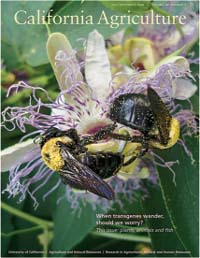All Issues
Letters: January-March 2007
Publication Information
California Agriculture 61(1):4-4.
Published January 01, 2007
PDF | Citation | Permissions
Full text
WHAT DO YOU THINK?
The editorial staff of California Agriculture welcomes your letters, comments and suggestions. Please write to us at calag@ucop.edu or 1111 Franklin St., 6th floor, Oakland, CA 94607. Include your full name and address. Letters may be edited for space and clarity.
When transgenes wander, he worries
Re: Norman Ellstrand's “When crop transgenes wander in California, should we worry?” (July-September 2006).
How many superweeds in our fields and pastures owe their existence to hybridization? We forget that the parent species of hybridized plants share common pathways of molecular evolution, and therefore “like” chemistries; the parent species have a much higher probability of evolving into the traited hybrid on their own, without human tampering.
Hybrids bring twigs on the tree of evolution together, under an umbrella of common plant chemistries, whereas genetic engineering will join the twig of one limb to the twig of another limb or to the limb itself, with a potential for radical new plant chemistries such that the definition of a species, namely the interbreeding of individuals, is challenged.
We don't have to pretend that we do transgenic modifications for the good of mankind when money is the goal, and we don't have to subject Mother Earth to experiments without an assured endpoint. Are we going to create a transgenic world by default? Perhaps we should consider inoculating another planet in the galaxy with the experiments of our transgenic tinkerings, and not be so readily willing to sacrifice our own and only life space to transgenic modifications.
Bud Hoekstra
Berry Blest Farm
San Andreas
Asian students appreciate journals
Editor's note: California Agriculture recently donated 12 boxes of journals, including Science, Scientific American and California Agriculture, to Bridge to Asia (BTA). Since its founding in 1987, BTA has collected and shipped more than 5 million books and periodicals to 1,000 universities in China, Vietnam and Cambodia.
Thank you for the journal and book donations from your publication. The journals are a valuable collection and are certain to be greatly appreciated and well used by students and teachers in Asia.
Our collection efforts are ongoing, and we welcome you to share your interest in Asia's need for books and journals with friends and colleagues who may wish to help.
Newton Liu, Vice President Bridge to Asia ( )
Correction
A formula was incorrect in “Cost benefit analysis conducted for nutrition education in California” (October-December 2006), on page 189 in both the “Calculation of direct benefits” box and table 2 footnote. The correct formula is:
A X B X C X D = E E X F = BenefitsThe authors (Joy and Goldman) regret the error.





